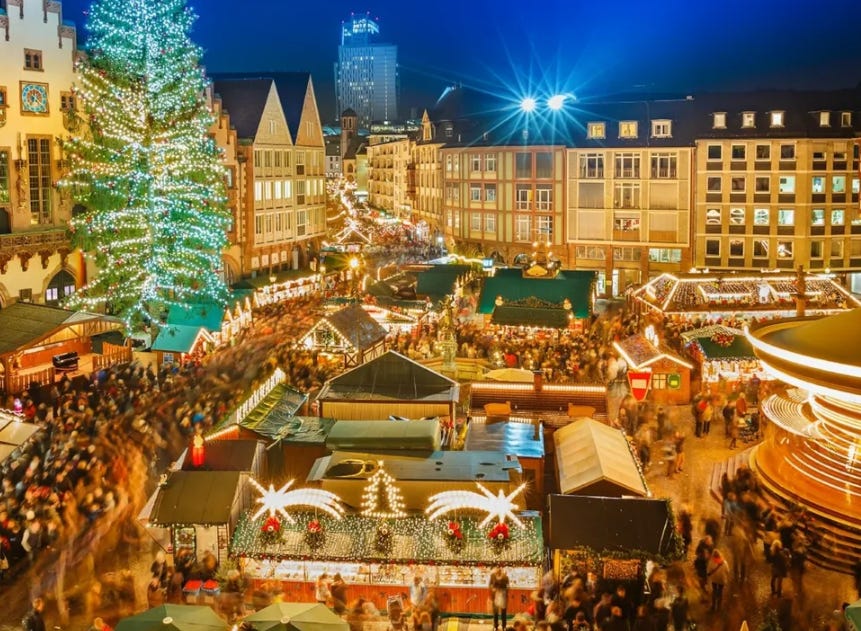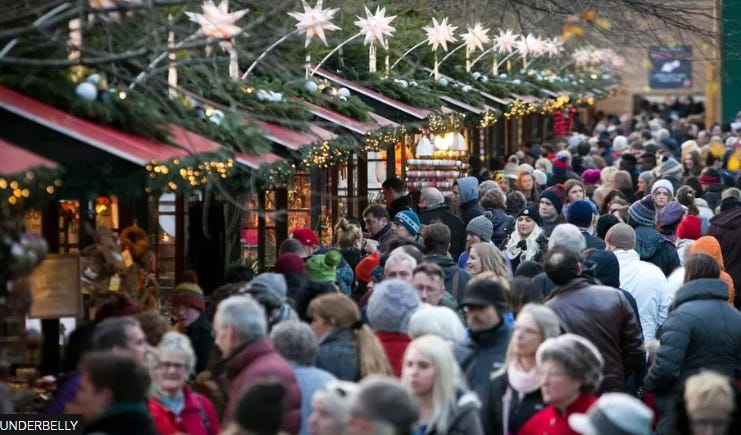Commercializing Ritual and Tradition - the Phenomenon of Christmas Markets | JOHN TIBBITT from Policies for Places
As I write there are at least 50 Christmas Markets underway in towns and cities across the UK, and many more in Europe and around the globe. They bring thousands of visitors, provide a boost to the tourist and hospitality industries and to local economies. They seem to attract impressive visitor numbers and to be popular among residents, but what we know about their economic and social impact beyond the basic statistics of estimated visitor numbers, additional spending and jobs created is limited so let’s explore this phenomenon a little more.

A brief social history
Christmas markets go back a long way. First recorded in 1298, the forerunner of the Christmas market as we know it was Vienna’s December Krippenmarkt held during Advent. In Germany, open-air winter street markets associated more with Christmas can trace their origins back to the 15th and 16th centuries, although it is unclear if these early events were held specifically for Christmas or were simply winter markets which took place around Christmas time. At that time many churches held markets for all religious feast days, with the winter market being the biggest. Typically the goods on sale were meat, baked goods, sweets and artisan pottery. Records are sparce but in later years the markets also began to offer everyday treats and eventually seasonal Christmas trees, toys, decorations and nativity scenes with singing and dancing.
They received a big boost in the 16th century when the teachings of protestant reformer Martin Luther suggested that the birth of Christ was a more appropriate time for giving gifts than other saints days. Churches which originally encouraged markets nearby to attract larger congregations, soon found themselves competing against the markets for their congregation, as festive markets became more and more popular.
The industrial revolution had a profound effect on Christmas markets. In Berlin for example, the Christmas Market grew from 303 stalls in 1805 to about 600 in 1840. Markets became perceived as ‘seedy, dangerous and threatening’, dominated by working class participation. From the end of the 19th century capitalist owners of new city centre department stores campaigned to have markets moved out of town to avoid competition, where they languished on city outskirts for many years.
Christmas Markets were brought back to German city centres in the 1930s at the behest of the Nazi Party who rapidly transformed Christmas from a religious holiday to a nationalist one extolling German heritage. Nazi politicians standardized the items stallholders could sell, focused on German-made ornaments, toys, crafts, and food and sweets. Leaders believed the sales of these goods would help revive the German economy after the recession and raise the morale of the population. People responded and visited markets in record numbers until many were closed at the start of World War II.
In the decades after the end of the war economic growth and the rise of consumerism fueled the resurgence of Christmas markets, transforming them into mass cultural events, so much so that by the 1980s and 90s they had become a major German cultural export as cities around the world began to host their own German-style Christmas markets complete with bratwurst, gluhwein and twinkling lights. In the UK the number of Christmas markets has more than tripled in recent years. Despite the hiatus caused by the COVID pandemic, markets continue to flourish whilst also having to respond to concerns over cost, safety and authenticity.
Impact
In 2017, Edinburgh’s Christmas market and related activities generated an estimated £113m for the local economy. A study claimed that the city’s Christmas events in the 6 weeks period to the end of the year attracted over 900,000 visitors, and that a record 771,000 tickets were sold for Christmas rides and attractions. It was estimated that the money generated was equivalent to over 2000 full-time jobs.

Whilst the Christmas Market is the centerpiece of Edinburgh’s winter festivals programme, which is marketed worldwide, there are other cities in the UK such as Bath and York which also host major Christmas Market events which collectively make a significant contribution to the UK’s winter economy. The Local Government Association (LGA) has studied the impact of these Markets in terms of the amount of income generated, the number of extra visitors attracted, and the number of jobs created.
The LGA also sought to investigate the impact of these temporary markets on more permanent traders to establish if there was a net gain for the local economy or merely displacement to the temporary market. It seems clear from their report that Markets attracted a high proportion of ‘out-of-town’ visitors, that average spend is rising, that additional spend is dispersed among other city businesses as well as at the Market. Markets attract a wider demographic than regular markets in the UK and are seen to offer something special. It seems that Christmas Markets are becoming a tourist destination in their own right alongside their counterparts elsewhere in Europe.
The impact on local populations as distinct from market consumer studies is under-researched. However studies do suggest that markets are usually popular among the local populations, despite frustrations from overcrowding in public places, traffic congestion and pressure on parking.
Where now?
The story of Christmas markets is one of continuing evolution. We have seen how medieval winter markets became events with a religious underpinning associated with sharing food on Saints days, and gift giving as part of the Christian celebrations of the birth of Jesus. Capitalism supported both the growth of mass markets in the 19th century as well as their demise as city-centre festivals in the face of competition around the turn of the century, only to be revived in the cause of Nationalism in the mid-20th century.
Christmas markets have evolved from religious to secular events. There can be little doubt that Christmas Markets now have the status of global cultural commodities, built on the traditions of earlier manifestations of winter celebrations. They are now cultural and retail events that create recreational value for visitors and locals alike. They can be seen as a form of ritual which brings people together, usually in public places, and designed to create a festive atmosphere where it is easy to forget their origins in religious and cultural traditions and values.
They do have their critics who cite their lack of authenticity in the face weakening connection to the meaning of these celebrations, the mass-produced decorations and gifts on the stalls and fairground rides which often dominate the markets themselves. Increased security since the terrorist attacks on Berlin Christmas Market in 2016 has changed the atmosphere somewhat and led to restrictions on unhindered access to market sites. The arrival of throngs of tourists risks Christmas markets becoming a destination and an experience rather than an event of cultural value.
Their resurgent popularity nevertheless suggests that the popular desire for a socially-shared festive experience remains strong. However Christmas markets will have to continue to evolve in the face of social change, or risk becoming ritualized celebrations of commercialism. There are already examples of smaller community-based markets which encourage local traders and enhance community participation and identity. A Zero Waste Market in a local district in London, for example, drew attention to a major issue of current times and reportedly attracted overwhelmingly positive feedback. Perhaps it is time to move on from commercial exploitation of ritualized traditions to more purposeful community engagement.
Source: Susbtack
 Printer-friendly version
Printer-friendly version- Login to post comments





